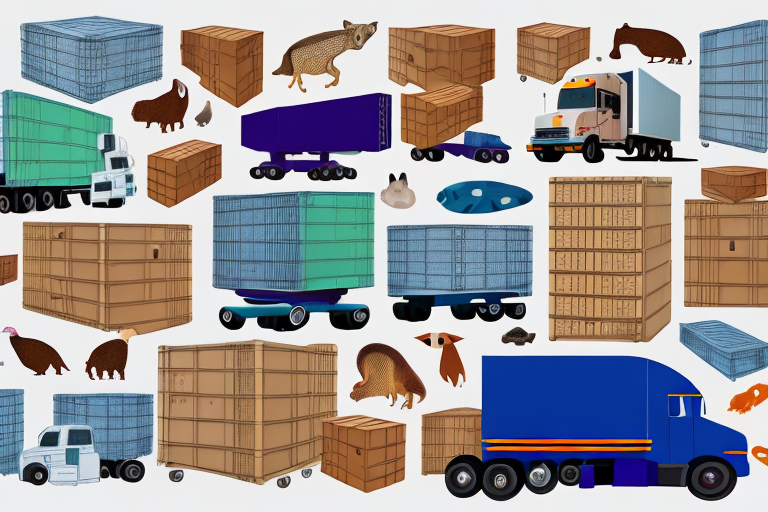Shipping Live Animals with UPS: A Comprehensive Guide
If you're considering shipping live animals with UPS, it's crucial to understand the shipping rates and associated factors that can impact the safety and well-being of your animals. In this article, we'll take a closer look at how to determine the correct shipping rate, the types of live animals that can be shipped through UPS, and what to expect during the delivery process. Additionally, we'll share some tips for preparing your live animal for shipping and review common mistakes that should be avoided.
The Importance of Understanding UPS Shipping Rates for Live Animals
Shipping live animals is a delicate process that requires careful consideration to ensure the animals arrive safely and in good health. Understanding the rates and costs associated with this type of shipping is essential. Several factors can impact the cost, including the weight and size of the animal, the type of animal, the destination, and the delivery method. According to the UPS Shipping Solutions, utilizing a comprehensive rate calculator can help you prepare for the shipping process and avoid unexpected fees.
Key Factors Influencing Shipping Costs
- Weight and Size: Heavier and larger animals typically incur higher shipping fees due to increased handling and transportation requirements.
- Type of Animal: Different animals may have specific shipping regulations and care requirements, impacting the overall cost.
- Destination: Shipping to remote or international locations often results in higher rates due to longer distances and additional regulatory compliance.
- Delivery Method: Expedited shipping methods, such as overnight delivery, will generally cost more than standard shipping options.
Temperature Control and Specialized Packaging
One important factor to consider when shipping live animals is maintaining an appropriate temperature. Extreme temperatures can be harmful to animals, so choosing a shipping method that can preserve a safe temperature throughout the journey is essential. This may require additional fees for specialized packaging and temperature-controlled transportation. For instance, shipping reptiles or amphibians might necessitate insulated containers and cooling packs to ensure their well-being.
Regulatory Documentation
Another consideration is the documentation required for shipping live animals. Depending on the type of animal and the destination, you may need to provide health certificates, permits, and other paperwork. Failing to provide the necessary documentation can result in delays or even the refusal of shipment. Always consult the Animal and Plant Health Inspection Service (APHIS) for up-to-date regulations and requirements.
Types of Live Animals Eligible for Shipping through UPS
UPS allows the shipping of various live animals, including but not limited to tropical fish, amphibians, crustaceans, honeybees, and worms. However, some restrictions may apply based on specific regulatory requirements or country restrictions. Additionally, UPS may recommend different shipping methods for different types of animals. For example, live fish often need to be shipped by air for same-day delivery to ensure their survival.
Permitted and Prohibited Species
While UPS accommodates a range of live animals, certain species are prohibited due to safety concerns or transportation difficulties. Prohibited animals typically include:
- Primates
- Venomous reptiles
- Certain dog breeds with respiratory issues
Always verify the eligibility of your animal with UPS and relevant regulatory bodies before initiating a shipment.
Packaging and Labeling Requirements
Shipping live animals through UPS necessitates special packaging and labeling. The packaging must be sturdy enough to withstand the shipping process and provide adequate ventilation for the animals. Additionally, the package must be labeled with the words "Live Animals" and include the sender's and recipient's contact information. According to UPS guidelines, proper packaging ensures the safety and compliance of your shipment.
Determining the Correct Shipping Rate for Your Live Animal
The shipping rate for your live animal depends on several factors, such as the animal's weight and size, the shipping destination, and the delivery method. UPS utilizes a dimensional weight formula that considers a package's weight, size, and distance. Your shipment's specific characteristics will determine the charges, so using UPS's rate calculator is highly recommended to estimate the cost accurately.
Additional Fees and Considerations
Live animals require special handling, which may incur additional fees. For example:
- Temperature-Controlled Shipping: An extra charge for maintaining a safe temperature during transit.
- Permits and Documentation: Fees associated with obtaining necessary permits or providing required documentation.
Understanding all requirements and fees associated with shipping live animals is crucial before booking your shipment.
Factors Affecting UPS Shipping Rates for Live Animals
Several factors can influence UPS shipping rates, including distance, delivery method, package dimensions, and weight. Shipping a live animal to a remote location may cost more due to increased distance, while using expedited shipping options like overnight delivery will incur additional fees.
Regulatory Compliance and Special Handling
Certain live animals require special handling or permits, which can affect shipping rates. For instance, shipping a live reptile may necessitate additional permits and fees due to potential risks during transport. Additionally, maintaining specific temperature or humidity conditions can impact the overall cost. Researching and complying with all necessary regulations and requirements before shipping your live animal with UPS is essential.
Tips for Preparing Your Live Animal for Shipping with UPS
Proper preparation is vital to ensure the safe shipment of your live animal. Here are some essential tips:
- Health Check: Ensure your animal is healthy and free from injuries or illnesses before shipping.
- Research Regulations: Investigate specific requirements for the type of animal you intend to ship to comply with all relevant regulations.
- Plan Delivery Timing: Schedule deliveries during business hours to minimize the time your animal spends in transit.
Providing Adequate Food and Water
Ensure your animal has enough food and water for the duration of the journey. Use secure containers that prevent spills and label them clearly with the animal's name, breed, and any special handling instructions. This ensures proper care during the shipping process.
The Role of Packaging in Ensuring Safe and Secure Shipping of Live Animals
Proper packaging is critical to the safe and secure shipping of your live animal. Key packaging considerations include:
Cushioning and Protection
Provide enough cushioning to protect the animal against impact and stress during transit. Avoid using materials like paper that can be shredded and cause injuries.
Ventilation
For animals requiring ventilation, use packaging that allows for adequate air circulation to prevent suffocation. Specialized containers may be necessary for different species to ensure their comfort and safety.
Clear Labeling
Label the package with clear and accurate information about the animal inside, including species, breed, age, and any special handling instructions. Include contact information for both the sender and receiver in case of emergencies during transit.
What to Expect During the Delivery Process of Your Live Animal with UPS
Upon delivery, it's essential to receive your live animal's shipment promptly, as leaving animals unattended can be detrimental to their health. Understanding the delivery process and committing to receiving the package at the specified location and time is crucial.
Preparing for Delivery
Before the delivery, ensure the animal is prepared for transportation by confirming its health, providing sufficient food and water, and using a suitable container. Label the container with the animal's name, species, and any necessary handling instructions.
Post-Delivery Care
After receiving the shipment, monitor the animal closely for any signs of stress or illness. Acclimate the animal slowly to its new environment by providing a comfortable and safe space for it to adjust. If you have concerns about the animal's health, contact UPS or a veterinarian for assistance.
Handling and Caring for Your Live Animal Upon Receiving It through UPS
Proper handling and care upon receiving your live animal are vital for its well-being. Here are key steps to follow:
Setting Up the Enclosure
Ensure that the animal's enclosure matches its specific needs, including appropriate temperature, humidity, food, and water. This helps reduce stress and promotes a smooth transition.
Quarantine Procedures
Quarantine your new animal for a period before introducing it to other animals to prevent the spread of potential diseases or parasites picked up during shipping. Monitor the animal closely for any signs of illness or distress during this period.
Providing Extra Care
Shipping can be stressful for animals, so provide extra care and attention during the adjustment period. Ensure a comfortable and secure environment to help your animal acclimate to its new surroundings.
Common Mistakes to Avoid When Shipping Live Animals with UPS
Shipping live animals with UPS requires careful planning to avoid common mistakes that can jeopardize the health and safety of your animal. Here are some pitfalls to watch out for:
- Poor Packaging: Inadequate packing can result in injuries or stress during transit. Use appropriate, sturdy, and secure containers tailored to your animal's needs.
- Non-Compliance with Regulations: Neglecting to comply with specific shipping regulations can incur fines or lead to shipment refusal. Always research and adhere to all relevant laws and guidelines.
- Insufficient Documentation: Failing to provide necessary health certificates or permits can delay or prevent your animal from being shipped. Ensure all paperwork is complete and accurate.
By avoiding these mistakes through thorough research and preparation, you can ensure a safe and healthy delivery for your live animal.
Conclusion: Ensuring a Safe Shipping Experience
By following these guidelines and understanding the intricacies of UPS shipping rates for live animals, you can help ensure a seamless and stress-free shipping experience for both you and your animal. Proper preparation, packaging, and care are essential components of safely shipping live animals. Remember to consult reputable sources and stay informed about current regulations to facilitate a smooth and successful shipment.
It is important to note that not all animals are eligible for shipping with UPS. Some animals, such as primates and venomous reptiles, are prohibited from shipping due to safety concerns. Additionally, certain breeds of dogs may be restricted from air travel due to respiratory issues. Always check with UPS and the appropriate regulatory agencies to ensure that your animal is eligible for shipping and to obtain any necessary permits or certifications.




















